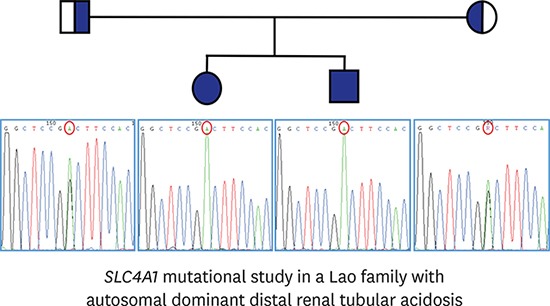1. Rodríguez Soriano J. Renal tubular acidosis: the clinical entity. J Am Soc Nephrol. 2002; 13(8):2160–2170. PMID:
12138150.

2. Fry AC, Karet FE. Inherited renal acidosis. Physiology (Bethesda). 2007; 22:202–211. PMID:
17557941.
3. Batlle D, Haque SK. Genetic causes and mechanisms of distal renal tubular acidosis. Nephrol Dial Transplant. 2012; 27(10):3691–3704. PMID:
23114896.

4. Karet FE, Finberg KE, Nelson RD, Nayir A, Mocan H, Sanjad SA, et al. Mutations in the gene encoding B1 subunit of H
+-ATPase cause renal tubular acidosis with sensorineural deafness. Nat Genet. 1999; 21(1):84–90. PMID:
9916796.
5. Smith AN, Skaug J, Choate KA, Nayir A, Bakkaloglu A, Ozen S, et al. Mutations in
ATP6N1B, encoding a new kidney vacuolar proton pump 116-kD subunit, cause recessive distal renal tubular acidosis with preserved hearing. Nat Genet. 2000; 26(1):71–75. PMID:
10973252.
6. Karet FE, Gainza FJ, Györy AZ, Unwin RJ, Wrong O, Tanner MJ, et al. Mutations in the chloride-bicarbonate exchanger gene
AE1 cause autosomal dominant but not autosomal recessive distal renal tubular acidosis. Proc Natl Acad Sci USA. 1998; 95(11):6337–6342. PMID:
9600966.
7. Tanphaichitr VS, Sumboonnanonda A, Ideguchi H, Shayakul C, Brugnara C, Takao M, et al. Novel
AE1 mutations in recessive distal renal tubular acidosis: loss-of-function is rescued by glycophorin. J Clin Invest. 1998; 102(12):2173–2179. PMID:
9854053.
8. Yenchitsomanus PT, Vasuvattakul S, Kirdpon S, Wasanawatana S, Susaengrat W, Sreethiphayawan S, et al. Autosomal recessive distal renal tubular acidosis caused by G701D mutation of anion exchanger 1 gene. Am J Kidney Dis. 2002; 40(1):21–29. PMID:
12087557.

9. Sritippayawan S, Sumboonnanonda A, Vasuvattakul S, Keskanokwong T, Sawasdee N, Paemanee A, et al. Novel compound heterozygous
SLC4A1 mutations in Thai patients with autosomal recessive distal renal tubular acidosis. Am J Kidney Dis. 2004; 44(1):64–70. PMID:
15211439.
10. Bruce LJ, Wrong O, Toye AM, Young MT, Ogle G, Ismail Z, et al. Band 3 mutations, renal tubular acidosis and South-East Asian ovalocytosis in Malaysia and Papua New Guinea: loss of up to 95% band 3 transport in red cells. Biochem J. 2000; 350(Pt 1):41–51. PMID:
10926824.

11. Choo KE, Nicoli TK, Bruce LJ, Tanner MJ, Ruiz-Linares A, Wrong OM. Recessive distal renal tubular acidosis in Sarawak caused by
AE1 mutations. Pediatr Nephrol. 2006; 21(2):212–217. PMID:
16252102.
12. Anacleto FE, Bruce LJ, Clayton P, Hegde S, Resontoc LP, Wrong O. Distal renal tubular acidosis in Filipino children, caused by mutations of the anion-exchanger SLC4A1 (AE1, Band 3) gene. Nephron, Physiol. 2010; 114(2):19–24.
13. Shmukler BE, Kedar PS, Warang P, Desai M, Madkaikar M, Ghosh K, et al. Hemolytic anemia and distal renal tubular acidosis in two Indian patients homozygous for
SLC4A1/
AE1 mutation A858D. Am J Hematol. 2010; 85(10):824–828. PMID:
20799361.
14. Fawaz NA, Beshlawi IO, Al Zadjali S, Al Ghaithi HK, Elnaggari MA, Elnour I, et al. dRTA and hemolytic anemia: first detailed description of
SLC4A1 A858D mutation in homozygous state. Eur J Haematol. 2012; 88(4):350–355. PMID:
22126643.
15. Khositseth S, Bruce LJ, Walsh SB, Bawazir WM, Ogle GD, Unwin RJ, et al. Tropical distal renal tubular acidosis: clinical and epidemiological studies in 78 patients. QJM. 2012; 105(9):861–877. PMID:
22919024.

16. Yenchitsomanus P, Sawasdee N, Paemanee A, Keskanokwong T, Vasuvattakul S, Bejrachandra S, et al. Anion exchanger 1 mutations associated with distal renal tubular acidosis in the Thai population. J Hum Genet. 2003; 48(9):451–456. PMID:
12938018.
17. Vasuvattakul S, Yenchitsomanus PT, Vachuanichsanong P, Thuwajit P, Kaitwatcharachai C, Laosombat V, et al. Autosomal recessive distal renal tubular acidosis associated with Southeast Asian ovalocytosis. Kidney Int. 1999; 56(5):1674–1682. PMID:
10571775.

18. Chu C, Woods N, Sawasdee N, Guizouarn H, Pellissier B, Borgese F, et al. Band 3 Edmonton I, a novel mutant of the anion exchanger 1 causing spherocytosis and distal renal tubular acidosis. Biochem J. 2010; 426(3):379–388. PMID:
20028337.

19. Liu SC, Jarolim P, Rubin HL, Palek J, Amato D, Hassan K, et al. The homozygous state for the band 3 protein mutation in Southeast Asian Ovalocytosis may be lethal. Blood. 1994; 84(10):3590–3591. PMID:
7949112.
20. Khositseth S, Sirikanaerat A, Khoprasert S, Opastirakul S, Kingwatanakul P, Thongnoppakhun W, et al. Hematological abnormalities in patients with distal renal tubular acidosis and hemoglobinopathies. Am J Hematol. 2008; 83(6):465–471. PMID:
18266205.









